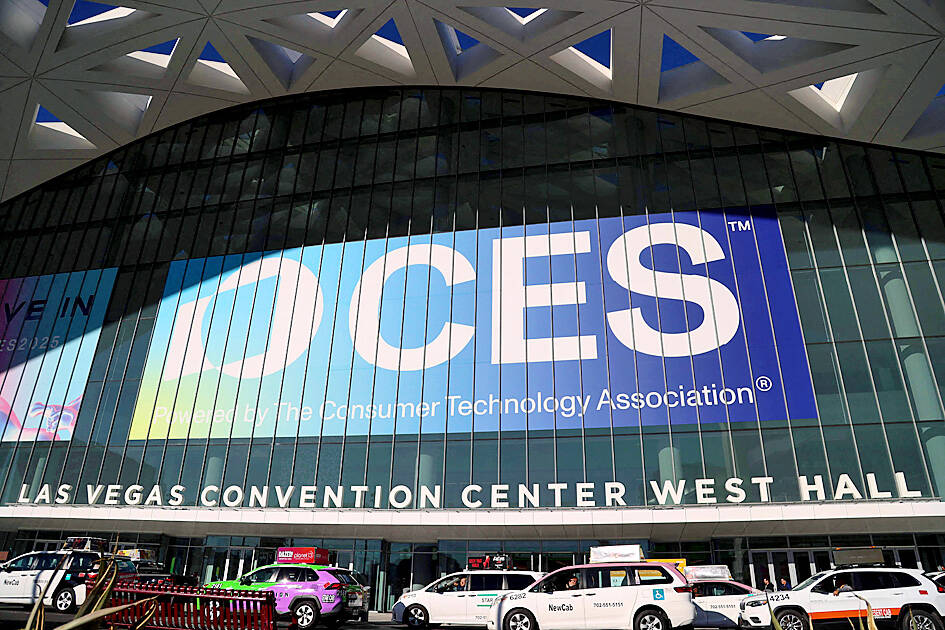With its focus on innovative products and cutting-edge technology, the annual CES has not historically paid much attention to energy companies.
However, there were signs of a shift at this year’s Las Vegas event, as the tech sector begins to confront its substantial energy needs, which are certain to grow as cloud computing and artificial intelligence (AI) advance.
“If you’d asked me to do CES five years ago, I wouldn’t necessarily have seen the point,” said Sebastien Fiedorow, chief executive of the French start-up Aerleum, which manufactures synthetic fuel from carbon dioxide.

Photo: AFP
“But we are in a very different CES than five years ago,” he said, adding that even if energy companies remain “on the fringes” of CES, “we’re here.”
Data centers accounted for 4.4 percent of US electricity needs in 2023, a figure that is likely to rise to 12 percent by 2028, the US Department of Energy said.
Gary Shapiro, chief executive of the Consumer Technology Association, which organizes CES, said energy transition was intended to be “a big focus” of this year’s show.
“It’s something we’ve talked about for a while,” he said, stressing that the tech sector needs “innovative solutions” to ensure it has the power it requires.
Among the companies pitching such innovation at CES, which wrapped up on Friday, was the Dutch firm LV Energy BV, which generates electricity from sound and vibrations.
The company’s general director Satish Jawalapersad said their presence at the show was noteworthy.
“The fact that we’re here with the CES does say something, definitely,” he said.
LV Energy did not mention AI in its presentation, which he said likely suppressed interest, with AI being “the magic word” at CES.
“Maybe we’re not the most sexy ... because we don’t say those words,” he said.
Other energy firms also acknowledged a struggle to break through. DataGreen, another French firm, aims to build smaller, greener data centers that run on renewable energy, saving tech companies money by reducing data storage costs.
Cloud computing giants have so far shown no interest, DataGreen’s AI head Julien Choukroun said.
“For now, they don’t see the point, but we’re trying to convince them,” Choukroun said.
The company won an innovation award at CES this year, its first appearance at the show, and Choukroun said its services are essential.
“We can’t continue to increase the hangar space [of data centers],” he said, stressing the land available “is not infinite.”
He voiced confidence that once Big Tech realizes DataGreen offers cost savings, that would “be more persuasive than the ‘green’” aspect.
Jordan Huyghe, product manager at the French firm Otrera, which designs small nuclear reactors, said a major change in the relationship between tech and the energy sector would require investment from giants such as Amazon.com Inc, Google or Microsoft Corp. Amazon is already the world’s largest purchaser of renewable energy.
In September last year, Microsoft signed a deal with Constellation Energy Corp to reopen the Three Mile Island power plant in Pennsylvania. Energy from the plant would power Microsoft data centers.
Solutions could come from companies big enough to fund them, Huyghe said.
“To move forward on projects like these, you need to raise money,” he said.

Taiwan Semiconductor Manufacturing Co (TSMC, 台積電) last week recorded an increase in the number of shareholders to the highest in almost eight months, despite its share price falling 3.38 percent from the previous week, Taiwan Stock Exchange data released on Saturday showed. As of Friday, TSMC had 1.88 million shareholders, the most since the week of April 25 and an increase of 31,870 from the previous week, the data showed. The number of shareholders jumped despite a drop of NT$50 (US$1.59), or 3.38 percent, in TSMC’s share price from a week earlier to NT$1,430, as investors took profits from their earlier gains

In a high-security Shenzhen laboratory, Chinese scientists have built what Washington has spent years trying to prevent: a prototype of a machine capable of producing the cutting-edge semiconductor chips that power artificial intelligence (AI), smartphones and weapons central to Western military dominance, Reuters has learned. Completed early this year and undergoing testing, the prototype fills nearly an entire factory floor. It was built by a team of former engineers from Dutch semiconductor giant ASML who reverse-engineered the company’s extreme ultraviolet lithography (EUV) machines, according to two people with knowledge of the project. EUV machines sit at the heart of a technological Cold

Taiwan’s long-term economic competitiveness will hinge not only on national champions like Taiwan Semiconductor Manufacturing Co. (TSMC, 台積電) but also on the widespread adoption of artificial intelligence (AI) and other emerging technologies, a US-based scholar has said. At a lecture in Taipei on Tuesday, Jeffrey Ding, assistant professor of political science at the George Washington University and author of "Technology and the Rise of Great Powers," argued that historical experience shows that general-purpose technologies (GPTs) — such as electricity, computers and now AI — shape long-term economic advantages through their diffusion across the broader economy. "What really matters is not who pioneers

TAIWAN VALUE CHAIN: Foxtron is to fully own Luxgen following the transaction and it plans to launch a new electric model, the Foxtron Bria, in Taiwan next year Yulon Motor Co (裕隆汽車) yesterday said that its board of directors approved the disposal of its electric vehicle (EV) unit, Luxgen Motor Co (納智捷汽車), to Foxtron Vehicle Technologies Co (鴻華先進) for NT$787.6 million (US$24.98 million). Foxtron, a half-half joint venture between Yulon affiliate Hua-Chuang Automobile Information Technical Center Co (華創車電) and Hon Hai Precision Industry Co (鴻海精密), expects to wrap up the deal in the first quarter of next year. Foxtron would fully own Luxgen following the transaction, including five car distributing companies, outlets and all employees. The deal is subject to the approval of the Fair Trade Commission, Foxtron said. “Foxtron will be